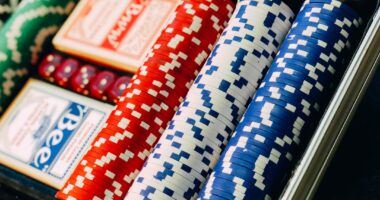Non-fungible tokens (NFTs) are unique digital assets that represent ownership or authenticity of specific items or content, such as artwork, videos, music, or social media posts. Unlike fungible cryptocurrencies like Bitcoin or Ethereum, which can be exchanged on a one-to-one basis, NFTs are non-interchangeable due to their distinct characteristics. NFTs utilize blockchain technology, a decentralized and distributed digital ledger that records transactions across multiple computers.
This technology ensures each NFT’s uniqueness and prevents replication. When created, an NFT receives a unique digital signature, making it verifiable and tamper-proof. This signature is the source of an NFT’s value and authenticity.
Various online platforms facilitate the buying, selling, and trading of NFTs. The blockchain records the ownership and transaction history of each NFT, providing transparency and security for all parties involved. In essence, NFTs are blockchain-based digital assets representing ownership or authenticity of specific items or content.
Their uniqueness and verifiability are ensured by blockchain technology, and they can be traded on dedicated platforms with their entire transaction history recorded on the blockchain.
Key Takeaways
- NFTs are unique digital assets that represent ownership of a specific item or piece of content on the blockchain.
- When choosing a platform for your NFT design, consider factors such as fees, user base, and the platform’s reputation in the NFT community.
- Creating unique and desirable artwork for your NFT involves understanding current trends, experimenting with different styles, and engaging with your audience for feedback.
- Utilizing controversial techniques, such as incorporating political or social commentary, can increase the value and appeal of your NFT to potential buyers.
- Marketing and promoting your NFT to potential buyers involves leveraging social media, collaborating with influencers, and participating in NFT marketplaces and events.
Choosing the Right Platform for Your NFT Design
When it comes to creating and selling NFTs, choosing the right platform is crucial to the success of your venture. There are several online marketplaces and platforms that specialize in NFTs, each with its own set of features, fees, and audience. Some of the most popular platforms for selling NFTs include OpenSea, Rarible, Foundation, and SuperRare.
These platforms allow artists and creators to mint, list, and sell their NFTs to a global audience. When choosing a platform for your NFT design, it’s important to consider factors such as fees, audience reach, ease of use, and community engagement. Some platforms charge a minting fee or a percentage of the sale price, so it’s important to factor these costs into your pricing strategy.
Additionally, consider the platform’s user interface and how easy it is to navigate and list your NFTs. Community engagement is also important, as some platforms have active communities that can help promote and support your work. Ultimately, the right platform for your NFT design will depend on your specific goals and needs.
Consider the fees, audience reach, ease of use, and community engagement when making your decision.
Creating Unique and Desirable Artwork for Your NFT

Creating unique and desirable artwork is essential when it comes to designing NFTs that will attract buyers and collectors. With the growing popularity of NFTs, the market has become increasingly competitive, making it crucial for artists to stand out with their creations. When creating artwork for NFTs, consider factors such as originality, quality, and relevance to current trends.
Originality is key when it comes to creating artwork for NFTs. Buyers are looking for unique and one-of-a-kind pieces that they can’t find anywhere else. Consider experimenting with different styles, techniques, and subject matters to create something truly original and captivating.
Quality is also important, as buyers are willing to invest in high-quality digital art that is visually appealing and well-executed. Pay attention to details such as resolution, color accuracy, and overall presentation to ensure that your artwork meets high standards. Relevance to current trends can also play a role in the desirability of your artwork.
Consider incorporating popular themes, styles, or cultural references that resonate with current trends and interests. This can help your artwork appeal to a wider audience and increase its marketability. In conclusion, creating unique and desirable artwork for your NFT involves focusing on originality, quality, and relevance to current trends.
Experiment with different styles and techniques to create something truly original, pay attention to details such as resolution and color accuracy, and consider incorporating popular themes or cultural references.
Utilizing Controversial Techniques to Increase the Value of Your NFT
In the competitive world of NFT design, some artists have turned to controversial techniques to increase the value of their digital assets. One such technique is “tokenizing” physical artwork, where artists create digital representations of their physical art pieces and sell them as NFTs. While this practice has sparked debate within the art community, it has also proven to be a lucrative strategy for some artists.
Another controversial technique involves leveraging celebrity or influencer endorsements to increase the value of NFTs. By collaborating with well-known figures in the entertainment or art world, artists can attract more attention and demand for their NFTs. However, this practice has raised ethical concerns about the commodification of celebrity endorsements and the impact on the value of digital art.
Additionally, some artists have used shock value or provocative content to generate buzz and demand for their NFTs. By creating controversial or boundary-pushing artwork, artists can attract attention from collectors and investors who are drawn to bold and unconventional pieces. However, this approach can also be polarizing and may alienate certain segments of the audience.
In summary, controversial techniques such as tokenizing physical artwork, leveraging celebrity endorsements, and using shock value can be used to increase the value of NFTs. While these strategies have proven effective for some artists, they have also sparked debate within the art community and raised ethical concerns about the commodification of art and celebrity endorsements.
Marketing and Promoting Your NFT to Potential Buyers
Once you have created your NFT artwork, the next step is to market and promote it to potential buyers. With the growing number of NFTs being minted and listed for sale, it’s important to stand out from the crowd and attract attention to your digital assets. There are several strategies you can use to market and promote your NFTs effectively.
One effective strategy is to leverage social media platforms to showcase your artwork and engage with potential buyers. Platforms such as Twitter, Instagram, and TikTok are popular channels for promoting NFTs and connecting with art enthusiasts and collectors. Share behind-the-scenes content, work-in-progress updates, and engaging visuals to build anticipation for your NFT release.
Another strategy is to participate in online communities and forums dedicated to NFTs and digital art. Engage in discussions, share your work, and connect with other artists and collectors to build a network of supporters who can help promote your NFTs. Building relationships within these communities can also lead to collaborations and partnerships that can further enhance the visibility of your artwork.
Consider collaborating with influencers or partnering with established brands to reach a wider audience with your NFTs. By leveraging existing networks and audiences, you can increase the exposure of your artwork and attract potential buyers who may not have discovered your work otherwise. In conclusion, marketing and promoting your NFT involves leveraging social media platforms, participating in online communities, and collaborating with influencers or brands to reach potential buyers.
By engaging with art enthusiasts and collectors, sharing behind-the-scenes content, and building relationships within online communities, you can effectively promote your NFTs and attract attention to your digital assets.
Navigating the Legal and Ethical Considerations of NFT Design

As the popularity of NFTs continues to grow, it’s important for artists and creators to navigate the legal and ethical considerations of NFT design. One key consideration is copyright law, as artists must ensure that they have the legal right to mint and sell their digital assets as NFTs. This involves understanding intellectual property rights, licensing agreements, and potential conflicts with existing copyrights.
Another legal consideration is the terms of service of the platform where you plan to sell your NFTs. Each platform has its own set of rules and guidelines that govern the creation and sale of NFTs. It’s important to review these terms carefully to ensure compliance with platform policies and avoid potential legal issues.
Ethical considerations also play a role in NFT design, particularly when it comes to environmental impact. The energy consumption associated with blockchain technology has raised concerns about the carbon footprint of NFTs. Artists should consider the environmental implications of minting and selling NFTs and explore ways to minimize their impact on the planet.
In summary, navigating the legal and ethical considerations of NFT design involves understanding copyright law, platform terms of service, and environmental impact. By ensuring compliance with intellectual property rights, reviewing platform policies, and considering the environmental implications of NFTs, artists can create digital assets responsibly and ethically.
Exploring Job Opportunities in the NFT and Crypto Space
The rise of NFTs has created new job opportunities in the art world as well as in the broader crypto space. From artists and designers to developers and marketers, there are various roles available for individuals looking to pursue a career in the NFT industry. One potential career path is becoming an NFT artist or designer.
As demand for unique digital artwork continues to grow, there is an increasing need for talented artists who can create compelling NFTs that resonate with collectors and investors. Artists can also explore opportunities in creating custom NFT collections for brands or collaborating with influencers on exclusive releases. Another career opportunity is in blockchain development and technology.
As the backbone of NFTs, blockchain technology plays a crucial role in ensuring the security and authenticity of digital assets. Developers with expertise in blockchain technology are in high demand as companies continue to explore new applications for NFTs beyond art. Marketing and promotion are also key areas within the NFT space that offer job opportunities.
Companies specializing in NFTs often seek individuals with experience in digital marketing, social media management, and community engagement to help promote their digital assets effectively. In conclusion, there are various job opportunities available in the NFT industry for individuals interested in pursuing a career in art, technology, marketing, or development. From artists and designers to developers and marketers, there are diverse roles within the NFT space that cater to different skill sets and interests.
FAQs
What is an NFT?
An NFT, or non-fungible token, is a digital asset that represents ownership or proof of authenticity of a unique item or piece of content, such as artwork, music, videos, or collectibles, using blockchain technology.
What are the controversial techniques for designing an NFT?
Controversial techniques for designing an NFT may include using copyrighted material without permission, creating NFTs without adding significant value to the original content, or exploiting the environmental impact of blockchain technology.
What are the key considerations when designing an NFT?
Key considerations when designing an NFT include ensuring the originality and authenticity of the content, adding value to the digital asset, obtaining the necessary rights and permissions for any copyrighted material, and being mindful of the environmental impact of blockchain technology.
How can one ensure the ethical design of an NFT?
To ensure the ethical design of an NFT, creators should prioritize originality and authenticity, obtain proper rights and permissions for any copyrighted material, add significant value to the digital asset, and consider the environmental impact of blockchain technology. Additionally, engaging in transparent and fair practices is essential for ethical NFT design.





